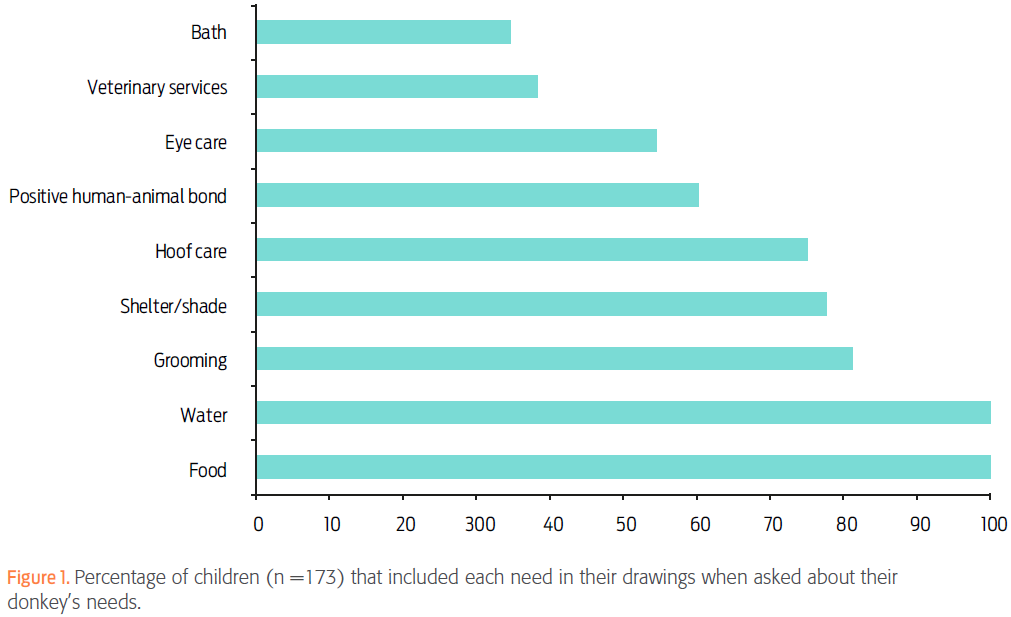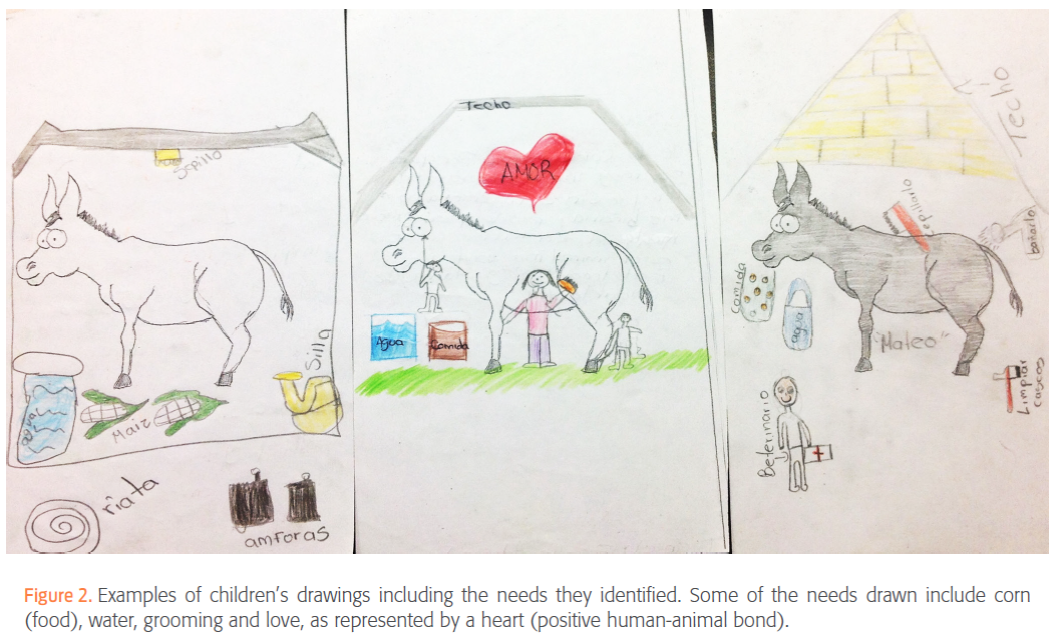Introduction
Working equids are still an important contributor to livelihoods in developing countries1. Often, the welfare of these animals may be put at risk because their owners lack knowledge of good husbandry practices2. The concept of the “Five Freedoms” (freedom from hunger and thirst; freedom from discomfort; freedom from pain, injury and disease; freedom to express normal behavior; and freedom from fear and distress) outlines some basic aspects of animal welfare that are under human control3. At the same time, animal welfare implies a moral obligation towards animals4. In practice, these freedoms can be achieved by the provision of resources aligned to the needs of animals5.
The term “needs” refers to certain necessities of life, which, in the case of animals without free choice, will lead to a reduction in the individual’s fitness or to suffering if they are not satisfied4. Being able to consider the needs of others is part of the process of caring6. This caring process is built upon the capacity to be receptive to the needs of another being; shifting one’s motivations to put others needs ahead of one’s own needs; and some form of acknowledgement from the recipient7.
In many areas of the world, working animals are crucial to families’ livelihoods, and children are directly involved in their care and management. If they are to be able to promote animal welfare, it is important that children understand that animals are sentient beings, that they have needs, and that attention to these needs is important to maintaining their welfare. The aim of this study was to assess the knowledge of children in the community of Tuliman regarding the needs of their donkeys. Tuliman is a community of approximately 3,500 inhabitants in the State of Guerrero in Mexico. In this community, the use of working equids for daily activities is essential, which is why the Donkey Sanctuary, together with the Veterinary Faculty of the Universidad Nacional Autonoma de Mexico (UNAM), provides veterinary services and promotes animal welfare. The Donkey Sanctuary is an international charity founded in 1969 that supports projects in 27 countries including Mexico. (www.thedonkeysanctuary.org.uk).
Materials and methods
During a period of two months, talks on animal welfare were delivered to 173 children, between 8 and 11 years of age, at three primary schools in the community of Tuliman. Children are usually involved in the daily care and management of donkeys, which are used for a variety of chores (as pack or traction animals) and usually receive less attention than horses and mules8. Talks were presented to children by Veterinarians through a community social service managed by the Donkey Sanctuary and UNAM.
Each session consisted of a theoretical activity where the concepts of animal welfare and animal needs were explained to the children by one of the Veterinarians of the program. Nine basic needs of working donkeys were taught to the children (Figure 1), followed immediately by a practical session in which children were asked to draw the needs of their donkeys. The instructor provided a drawing of a donkey to each child so that they could add the needs to the drawing, or write them if they preferred (Figure 2). The frequencies of the different needs registered by children in their drawings were determined and expressed as percentages. To do this, the resources drawn by children were classified into one of the nine needs described. For example, if children drew corn or a hay-bag this was counted as one need, in this case food. If one drawing presented more than one foodstuff, this was counted as 1 need (food). This was done to quantify the children’s recognition of these nine basic needs of donkeys.

Figure 1 Percentage of children (n = 173) that included each need in their drawings when asked about their donkey’s needs.
Results and discussion
All children (n = 173) were able to identify the provision of food and water as essential needs (Figure 1). These needs correspond to the first freedom (from hunger and thirst)3, and are probably easier for children to understand and remember because they participate directly in these activities. In this sense, children’s understanding of physiological needs has been reported to develop faster than their awareness of other needs, reaching full expression by age seven6. Provision of a grooming routine, shelter, and hoof care were also recognized as important needs (81 %, 77 % and 75 %, respectively; Figure 1). Skin problems, external parasites, heat stress and hoof problems are common problems in working equids across the world2,8,9. Encouragement of basic hoof cleaning and grooming, together with the provision of shelters/shade for donkeys to rest comfortably, can avoid welfare problems and allow animals to work in better conditions. Especially in the case of working equids, grooming and cleansing routines are important for health and welfare. This is because work causes sweating, which alters the natural balance of the skin. These waste products can clot the skin’s pores and prevent its natural breathing action. This is why cleansing needs to be performed to remove waste products and allow normal functioning of the skin10.
The establishment of positive human-animal interactions can reduce fear and stress in animals and increase productivity. In addition, positive attitudes towards animals can be important for human relationships. Fraser et al. reported that children should not mistreat animals because such actions may make children cruel or destructive11. Our results show that only 60 % of children recognized that positive attitudes towards their donkeys were important (Figure 1). When establishing educational programs, the inclusion of these aspects should be considered in order to teach children about animal welfare from a younger age. Children are also an important group for transferring information and promoting positive attitudes within their families. The role of children as agents of change was investigated by Damerell et al.12. Their study found strong evidence that environmental education can be transferred between generations and indirectly induce behavioral changes.
Eye problems, such as nasolacrimal duct obstruction accompanied by infection, are common in working donkeys9. Caring about eye cleanliness was only recognized as important by 54 % of children, and could be considered for inclusion in future talks. Bathing of donkeys was the least recognized need by children, with only 35 % of them including it in their drawings. Difficulties with access to water or lack of time for this aspect of care could have influenced the results, but a proper grooming routine might also be sufficient for maintaining skin health and avoiding the flies and external parasites that affect donkeys.
Notably, only 38 % of the children noted that the provision of veterinary services was important for donkeys (Figure 1). This could be the result of low availability and accessibility of veterinary services in the community, a problem that has been reported in other locations where working equids are still numerous2,8,9. Because children have not frequently observed veterinary services, they may not understand their importance in maintaining equid health.
From an ethical perspective, one should consider animal welfare important because we should protect the quality of life of all animals, not only because of their practical value in achieving some external goal (income generation), but because it is important in itself11. Educational programs can greatly influence people’s attitudes toward animals13, which is why the inclusion of pro-animal attitudes in children’s education should not only positively affect the human-animal bond but also the children’s levels of empathy towards people14. Among children 6 to 10 years of age, educational efforts should emphasize emotional concern and sympathy for animals as sentient beings, and later on emphasize factual knowledge such as the concepts of animal needs and the five freedoms, as, according to Kellert, there is an evolution in children’s perceptions of animals15. As stated by Myers et al., curricula could help children of all ages to be more aware of, articulate about, and able to balance, values related to environmental care6. Such curricula could also improve children’s perceptions of what animals need, and are thus an important strategy within environmental and animal welfare education. When developing these educational strategies, other factors such as ethnicity and rural/urban residence should also be considered15 so that the tools applied are adapted according to local needs.
Conclusions
Although our results are preliminary and descriptive, further investigation should be pursued to validate this methodology as a novel approach to working with children in communities. Differences between genders and ages should also be considered because the roles that girls and boys play in the care of donkeys might differ, as might their levels of empathy towards animals. Previous studies investigating levels of empathy toward animals have shown differences between genders, with women being more empathic16. These types of tools could also be applied before and after interventions to assess the effect of this type of intervention on children’s knowledge.
These results provide a first step towards understanding which concepts need to be reinforced in children. Therefore, they can create positive changes in attitudes towards animals and thus improve animal welfare.











 text in
text in 




